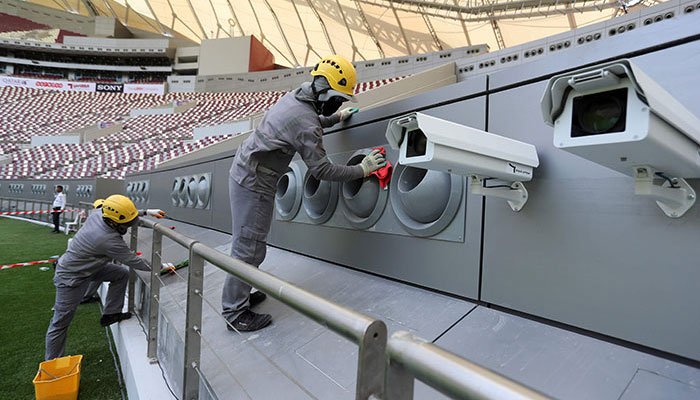DOHA: Qatar has become almost a byword for scorching heat, but some fans will still take a sweater to World Cup stadiums because of state-of-the-art air conditioning that its mastermind says will become the norm for mega sports events.
Saud Abdulaziz Abdul Ghani, nicknamed “Dr Cool”, worked for 13 years on the solar-powered cooling system that he says will keep the players and turf healthy and even eliminate body odour in a packed stadium.
The mercury can hit 50 degrees Celsius (122 Fahrenheit) during the Gulf state´s blistering summers, which is why this year´s World Cup was moved to the winter.
But even with maximum temperatures down to around 25 Celsius (77 Fahrenheit) for the tournament in November and December, cool air will still be pumped out onto the players and watching fans.
Stadium cooling is nothing new. The Superdome, home of the New Orleans Saints American football team, has 9,000 tonnes of air conditioning equipment.
“Dr Cool”, a professor of engineering at Qatar University who also helped develop cooling for the Ford Mondeo car, has however developed a system that World Cup organisers say is 40 percent more “sustainable” than existing techniques.
Seven of the eight stadiums are air-conditioned at a World Cup that organisers insist will be carbon-neutral.
At the 40,000-capacity Al Janoub Stadium, which will hold seven games including holders France´s first match, Saud said a two-metre-high “completely isolated bubble” of cool air will envelop the pitch and stands.
Inside the bubble, players and fans will be kept at 21 Celsius (70 Fahrenheit) by jets blasting air at the pitchside and under spectators´ seats.
Sensors around the stadium keep the temperature constant and even adjust air flows for seats in the shade or sun.
The rising air is sucked back into the stadium cooling system, cleaned by water kept at a brisk 7 degrees Celsius (44 Fahrenheit) and pumped out again by the jets.
“The players will have the best experience of their lives,” said Saud, highlighting how the chilled air would prevent injuries and illness suffered in extreme heat.
– Giant solar farm –
The power for the system comes from a giant solar farm in the desert outside the capital Doha, he added. The same technology is being used in greenhouses where Qatar grows increasing amounts of its own food.
“We have the best thermal insulation on our machines, the best sensory systems around the stadium,” said Saud.
And the air conditioning will still be needed in December, despite the cooler temperatures.
Each human generates the heat of two laptops and gives off 70 grams (2.5 ounces) of sweat per hour, according to Saud.
He gave the example of the Lusail Stadium where 80,000 people will gather for the World Cup final on December 18.
“They are there for four hours, so that is a lot of water. And I also have the heat of 160,000 laptops in that space. So that heat must be offset irrespective of whether it is winter, summer, autumn or spring.”
The use of air conditioning in stadiums remains controversial, however.
Russell Seymour, chief executive of the British Association for Sustainable Sport, said that while the technology and renewable energy in Qatar may work he had concerns about the wider message given by air conditioning an open space.
At a time when people are being urged to save energy “quite often people in an office will open the windows, they want fresh air but they´ve also got air conditioning on and then things compete, and that´s when the issues come”.
Saud said he is happy for any expert to inspect the system and check his sustainability claims. The technology has been made free of patent restrictions for anyone to copy.
He is also certain that future World Cups — particularly in 2026 in the United States, Mexico and Canada — will follow suit.
“In the future, for the safety of players, air-conditioned stadiums will be more of the norm,” he said.
As global temperatures rise due to climate change, “if you want players to complete the game without water breaks, without any interruptions then air conditioning will be a necessity”.


